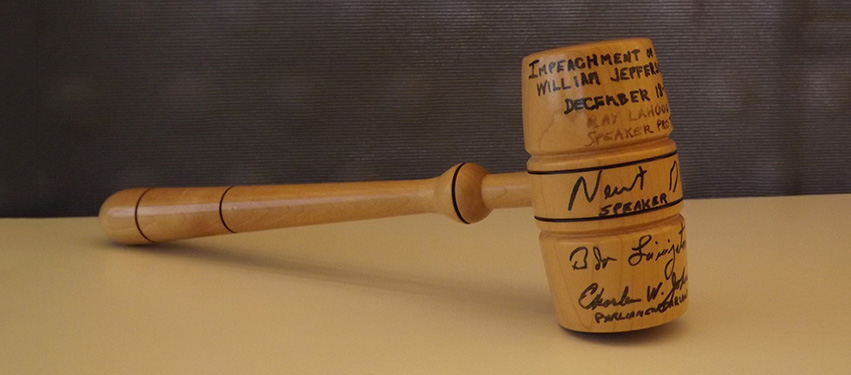On September 24, 2019, House Speaker Nancy Pelosi announced that the U.S. House of Representatives is moving forward with an official impeachment inquiry of President Trump. This is only the fourth time in history that impeachment proceedings have been brought against a U.S. president. Not surprisingly, the national news, social media and talk radio are consumed by this unfolding political drama. American citizens, however, are divided on the merits of moving forward and confused by the impeachment process. This article will explore the framework for impeachment, the history of presidential impeachment proceedings, and the current political landscape as Congress considers the process once again.
The Framework for Impeachment
Article I, Section 3, Clause 5 of the U.S. Constitution gives the House of Representatives the sole power to bring charges (Articles of Impeachment). If a simple majority approves the charges, it moves to the Senate.
Article 1, Section 3, Clause 6 gives the Senate the power to try the President, and the Chief Justice of the U.S. Supreme Court presides over the trial. The Senate must find the defendant guilty by a two-thirds voting margin (67 votes) and the main punishment is removal from office.
Article 11, Section 4 provides the grounds for impeachment: “The President, Vice President and all civil offices of the United States shall be removed from Office on Impeachment for, and Conviction of, Treason, Bribery, or other high Crimes and Misdemeanors.” The Constitution does not define high crimes and misdemeanors.
Proceedings Against President Andrew Johnson
On February 24, 1868, the House of Representatives voted impeachment on a party-line vote of 126-47 on the vague grounds of “high crimes and misdemeanors,” with specific charges to be drafted by a special committee. Eleven articles of impeachment were drafted and approved a week later by the House. Articles 1-8 charged President Johnson with illegally removing Secretary of War Edwin Stanton from office, Article 9 accused Johnson of violating the Command of the Army Act, and the last two articles charged Johnson with libeling Congress through “inflammatory and scandalous harangues.”
On May 26, 1868, after a trial in the U.S. Senate, President Johnson was acquitted by a final vote of 35 guilty and 19 not guilty—one vote shy of the two-thirds required for conviction. Johnson completed his presidential term, returned to his home state of Tennessee, and eventually was elected to the U.S. Senate, entering the site of his own impeachment trial.
Proceedings Against President Richard Nixon
Following the Watergate scandal, impeachment proceedings were formally initiated on February 6, 1974. At the end of July, the House Judiciary Committee approved three articles of impeachment for obstruction of justice (editing Watergate tapes), abuse of power (firing special prosecutor Archibald Cox) and contempt of Congress (firing Cox). Subsequently, the U.S. Supreme Court ruled that all Nixon White House tapes must be made public, revealing President Nixon’s deep involvement in the Watergate cover-up. On August 9, he became the first president ever to resign from office. Consequently, the three articles of impeachment were never voted on by the full House.
Proceedings Against President Bill Clinton
In early 1998, President Clinton’s affair with former White House intern Monica Lewinsky became public. Following that year’s midterm election, the House of Representatives initiated formal impeachment proceedings. Articles of impeachment were approved by the Judiciary Committee alleging that Clinton had perjured himself by lying to investigators about his relationship with Lewinsky and that he obstructed justice by encouraging White House staff to deny the affair. On December 19, 1998, the full House impeached President Clinton on the grounds of perjury by a 228-206 vote and obstruction of justice by a 221-212 vote.
The Senate trial began on January 7, 1999 with Chief Justice William Rehnquist presiding. On February 12, 1999, the Senate acquitted President Clinton on the perjury charge with a vote of 50 against conviction and 45 for conviction. The Senate also acquitted President Clinton on the obstruction of justice charge with a vote of 50 against conviction and 50 for conviction. During President Clinton’s House impeachment proceedings and the Senate trial, both chambers were led by Republican majorities.
Proceedings Against President Donald Trump
Currently, the U.S. House of Representatives is comprised of 235 Democrats, 199 Republicans and one Independent. The impeachment inquiry launched by Speaker Pelosi stemming from President Trump’s July phone call to Ukraine’s president asking him for “a favor” to investigate political rival Joe Biden and his son Hunter is now being investigated by House committees. This will likely result in the House Judiciary Committee drafting articles on impeachment, and could result in a full House vote by the end of 2019.
If the House votes to impeach President Trump, the process will then move to the U.S. Senate for a trial. The Senate is comprised of 53 Republicans, 45 Democrats and two Independents who usually vote with the Democrats. Conviction and removal of President Trump would require 67 votes, meaning at least 20 Republicans would have to vote to convict.
Conclusion
No president has ever been removed from office through House impeachment and Senate conviction. Indeed, the process to remove a president from an office the American people duly elected should be a serious and thoughtful undertaking.
Whether the evidence of President Trump’s actions rises to the level of “high crimes and misdemeanors” as set forth in the Constitution will be up to Congress to decide. Importantly, no president in U.S. history has ever gone through impeachment proceedings followed by an election for a second term. Ultimately, it may be American voters in the 2020 election who will decide if President Trump remains in office. PM




